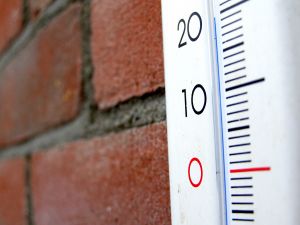

One of the most difficult survival situations is a cold weather scenario. Every time you venture into the cold, you are pitting yourself against the elements. Using these cold weather survival tips, proper planning and appropriate equipment, you can overcome the elements of cold.
Note that “cold” depends on your geography. Below-freezing temperatures in northern latitudes are considered mundane, but are seen as extreme cold in southern areas. These cold weather survival tips hold true regardless of location.
Cold Weather Survival Tip #1: Understand How Temperature Affects You
* Cold is a far greater threat to survival than it appears. It decreases your ability to think and weakens your will to do anything except to get warm.
* Cold is an insidious enemy; as it numbs the mind and body, it subdues the will to survive. Cold makes it very easy to forget your ultimate goal–to survive.
* Ocean currents affect cold weather and cause large areas normally included in the temperate zone to fall within the cold regions during winter periods.
* Elevation also has a marked effect on defining cold regions. Cold weather survival depends on recognizing weather patterns at your elevation.
Wet Cold Weather Environments
Wet cold weather conditions exist when the average temperature in a 24-hour period averages at or near 20 to 30° F. Characteristics of this condition are freezing during the colder night hours and thawing during the day.
Even though the temperatures are warmer during this condition, the terrain is usually very sloppy due to slush and mud. Cold weather survival must concentrate on protecting yourself from the wet ground and from freezing rain or wet snow.
Dry Cold Weather Environments
Dry cold weather conditions exist when the average temperature in a 24-hour period remains below 20°F. Even though the temperatures in this condition are much lower than normal, you do not have to contend with the freezing and thawing.
In these conditions, cold weather survival means more layers of inner clothing to protect you from temperatures as low as -30 degrees F. More extremely hazardous conditions exist when high wind and these low temperatures combine.
It is more difficult for you to satisfy your basic water, food, and shelter needs in a cold environment than in a warm environment. Even if you have the basic requirements, you must also have adequate protective clothing and a further dedicated will to survive. The will to survive is as important as the basic needs. There have been incidents when trained and well-equipped individuals have not survived cold weather survival situations because they lacked the will to live. Conversely, these will has sustained individuals less well trained and equipped.
You must not only have enough clothing to protect you from the cold, you must also know how to maximize the warmth you get from it. For example, always keep your head covered.
Cold weather survival often hinges on keeping the head warm. You can lose 40 to 45 percent of body heat from an unprotected head and even more from the unprotected neck, wrist, and ankles. These areas of the body are good radiators of heat and have very little insulating fat. The brain is very susceptible to cold and can stand the least amount of cooling. Because there is much blood circulation in the head, most of which is on the surface, you can lose heat quickly if you do not cover your head.
Cold Weather Survival Tip #2: Remember COLD
There are four basic principles to follow to keep warm for cold weather survival. An easy way to remember these basic principles is to use the word COLD.
C – Keep clothing CLEAN
O – Avoid OVER HEATING
L – Wear clothes LOOSE and in LAYERS.
D – Keep clothing DRY.
* Keep clothing clean. This cold weather survival principle is always important for sanitation and comfort. In winter, it is also important from the standpoint of warmth. Clothes matted with dirt and grease lose much of their insulation value. Heat can escape more easily from the body through the clothing's crushed or filled up air pockets.
* Avoid overheating. When you get too hot, you sweat and your clothing absorbs the moisture. This affects your warmth in two ways: dampness decreases the insulation quality of clothing, and as sweat evaporates, your body cools.
Adjust your clothing for cold weather survival so that you do not sweat. Do this by partially opening your parka or jacket, by removing an inner layer of clothing, by removing heavy outer mittens, or by throwing back your parka hood or changing to lighter headgear. The head and hands act as efficient heat dissipaters when overheated.
* Wear your clothing loose and in layers. Wearing tight clothing and footgear restricts blood circulation and invites cold injury. It also decreases the volume of air trapped between the layers, reducing its insulating value.
When it comes to cold weather survival, several layers of lightweight clothing are better than one equally thick layer of clothing, because the layers have dead-air space between them. The dead-air space provides extra insulation. Also, layers of clothing allow you to take off or add clothing layers to prevent excessive sweating or to increase warmth.
* Keep clothing dry. In cold weather survival situations, your inner layers of clothing can become wet from sweat and your outer layer, if not water repellent; can become wet from snow and frost melted by body heat. Wear water repellent outer clothing, if available. It will shed most of the water collected from melting snow and frost.
* Before entering a heated shelter, brush off the snow and frost. Despite the precautions you take, there will be times when you cannot keep from getting wet. This can become a major problem for cold weather survival. If you are walking out, hang your damp mittens and socks on your backpack to dry. Even in freezing temperatures, the wind and sun will dry your clothing.
* You can also place damp socks or mittens, unfolded, near your body so that your body heat can dry them. In a campsite, hang damp clothing inside the shelter near the top, using drying lines or improvised racks. You may even be able to dry each item by holding it before an open fire. Dry leather items slowly. If no other means are available for drying your boots, put them between your sleeping bag shell and liner. Your body heat will help to dry the leather.
A good quality insulated low temperature rating sleeping bag is one of the most valuable pieces of cold weather survival gear. If it is stuffed with down or even other lofted material insure that it remains dry. If it gets wet, it loses a lot of its insulation value. When it comes to personal protection items like a good cold weather sleeping bag you usually do get what you pay for. Where possible lay down pine boughs or aspen leaves or anything dry and available on the ground that you are sleeping on to insulate you from the conductive cold of the ground.
Cold Weather Survival Tip #3: Make a Survival Kit
Other important cold weather survival items are a knife; waterproof matches in a waterproof container, fire tinder, a durable compass; map; watch; waterproof ground cloth and cover; flashlight; binoculars; dark glasses; fatty emergency foods; food gathering gear; and signaling items.
Remember, a cold weather environment can be extremely harsh on your mind as well as your body. Give a good deal of thought to selecting the right equipment for increasing your chances of survival in the cold. If unsure of an item you have never used, or with any new item test it in an “overnight backyard” environment before venturing further.
It is after all your life and the life of others with you that you are protecting.
For further reading, be sure to check out how to make a winter survival kit to keep in your car, how to make a winter bug-out bag and how to survive a blizzard.


![Best Concealed Carry Guns In 2025 [Field Tested] Wilson Combat EDC X9S 1](https://gundigest.com/wp-content/uploads/Wilson-Combat-EDC-X9S-1-324x160.jpg)


![Best 9mm Carbine: Affordable PCCs [Tested] Ruger Carbine Shooting](https://gundigest.com/wp-content/uploads/Ruger-Carbine-Shooting-100x70.jpg)
![Best AR-15: Top Options Available Today [Field Tested] Harrington and Richardson PSA XM177E2 feature](https://gundigest.com/wp-content/uploads/Harrington-and-Richardson-PSA-XM177E2-feature-100x70.jpg)
